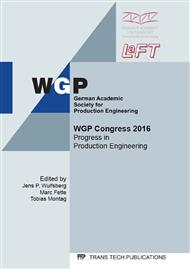[1]
Altintas, Y.: Manufacturing Automation: Metal Cutting Mechanics, Machine Tool Vibrations and CNC Design. Cambridge University Press (2000).
DOI: 10.1017/cbo9780511843723
Google Scholar
[2]
Altintas, Y., Budak, E.: Analytical Prediction of Stability Lobes in Milling. CIRP Annals – Manufacturing Technologies 44(1), 357–362 (1995).
DOI: 10.1016/s0007-8506(07)62342-7
Google Scholar
[3]
Altintas, Y., Kersting, P., Biermann, D., Budak, E., Denkena, B., Lazoglu, I.: Virtual Process Systems for Part Machining Operations. CIRP Annals – Manufacturing Technology 63(2), 585–605 (2014).
DOI: 10.1016/j.cirp.2014.05.007
Google Scholar
[4]
Altintas, Y., Weck, M.: Chatter Stability of Metal Cutting and Grinding. CIRP Annals – Manufacturing Technology 53(2), 619–642 (2004).
DOI: 10.1016/s0007-8506(07)60032-8
Google Scholar
[5]
Campa, F., Lopez de Lacalle, L., Celaya, A.: Chatter avoidance in the milling of thin floors with bull-nose end mills: Model and stability diagrams. International Journal of Machine Tools and Manufacture 51(1), 43–53 (2011).
DOI: 10.1016/j.ijmachtools.2010.09.008
Google Scholar
[6]
Coffignal, G., Lorong, P., Planchat, J., Yaqub, S., Larue, A.: Virtual Machining: A General Approach to Deal with Flexible Workpieces. In: Proceedings of the 10th International Workshop on Modeling of Machining Operations. University of Calabria (Italy) (2007).
Google Scholar
[7]
Denkena, B., Schmidt, C.: Experimental Investigation and Simulation of Machining Thin-Walled Workpieces. Production Engineering 1(4), 343–350 (2007).
DOI: 10.1007/s11740-007-0017-9
Google Scholar
[8]
Foley, J., Feiner, S., Hughes, J.: Introduction to Computer Graphics. Addison-Wesley, Reading, Mass (1994).
Google Scholar
[9]
Kersting, P., Biermann, D.: Modeling Techniques for Simulating Workpiece Deflections in NC Milling. CIRP Journal of Manufacturing Science and Technology 7(1), 48–54 (2014).
DOI: 10.1016/j.cirpj.2013.08.002
Google Scholar
[10]
Kersting, P., Odendahl, S.: Capabilities of a Process Simulation for the Analysis of Five-Axis Milling Processes in the Aerospace Industry. In: Proceedings of the 18th International Seminar on High Technology. Piracicaba, Brazil (2013).
Google Scholar
[11]
Leopold, M., Hense, R., Möhring, H.C., Kersting, P.: Intelligente Werkstückspannsysteme für die verzugsfreie Fertigung dünnwandiger Aluminiumbauteile. In: Tagungsband 12. Magdeburger Maschinenbau-Tage. Magdeburg (2015).
Google Scholar
[12]
Marinescu, I., Axinte, D.: A Timefrequency Acoustic Emission-Based Monitoring Technique to Identify Workpiece Surface Malfunctions in Milling with Multiple Teeth Cutting Simultaneously. International Journal of Machine Tools and Manufacture 49(1), 53–65 (2009).
DOI: 10.1016/j.ijmachtools.2008.08.002
Google Scholar
[13]
Siebrecht, T., Odendahl, S., Hense, R., Kersting, P.: Interpolation Method for the Oscillator-Based Modeling of Workpiece Vibrations. Proceedings of the 3rd International Conference on Virtual Machining Process Technology. Calgary (2014).
Google Scholar
[14]
Sellmeier, V., Denkena, B.: High Speed Process Damping in Milling. CIRP Journal of Manufacturing Science and Technology 5(1), 8–19 (2012).
DOI: 10.1016/j.cirpj.2011.12.001
Google Scholar
[15]
Surmann, T., Biermann, D.: The Effect of Tool Vibrations on the Flank Surface Created by Peripheral Milling. CIRP Annals – Manufacturing Technology 57(1), 375–378 (2008).
DOI: 10.1016/j.cirp.2008.03.059
Google Scholar
[16]
Schmitz, T.L., Smith, K.S.: Machining Dynamics Frequency Response to Improved Productivity. Springer (2009).
Google Scholar
[17]
Uriarte, L., Zatarain, M., Axinte, D., Yage-Fabra, J., Ihlenfeldt, S., Eguia, J., Olarra, A.: Machine tools for large parts. CIRP Annals – Manufacturing Technology 62(2), 731–750 (2013).
DOI: 10.1016/j.cirp.2013.05.009
Google Scholar


